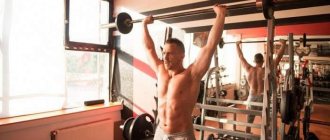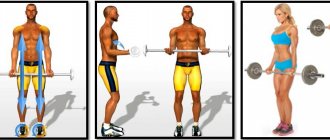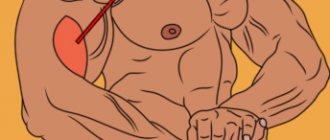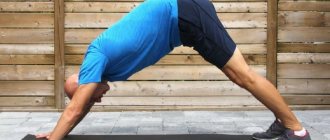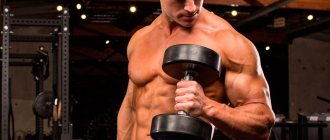The Scott bench, named after the first Mr. Olympia, is the best way for isolated and localized biceps work. Unlike standing barbell and dumbbell curls, the principle of the bench is that the biceps cannot have any helper muscles. Working on a special bench will help increase the volume and shape the “peak” of the biceps brachii muscle. Also, in addition to the bench, there is a block exercise machine “Larry-Scott”.
Medium grip straight bar curl technique
- Warm up your muscles and joints well.
- Prepare a straight bar of the required weight by placing it on special bench racks.
Step-by-step exercise algorithm:
- First, while standing, grab the bar with a shoulder-width grip, then sit on the bench, resting your elbows on the armrest, and lift the bar.
- Feet rest on the floor.
- Take a comfortable sitting position, having previously adjusted the seat height according to your height so that your shoulders do not ride up on the back of the machine, rest your chest.
- Exhale: Perform barbell curls on a Scott bench, squeezing your biceps as much as possible at the top.
- Inhale: slowly lower your arms without fully extending your elbows - this will prevent joint injuries and strained tendons.
- Work with moderate weight, as the muscles and ligaments are under a lot of tension. Choose a comfortable weight for 8-12 repetitions, perform 4 sets. It is advisable to work with an assistant; on the last difficult repetitions, the insurer, with a little effort, will help to qualitatively refine the approach.
- On the last rep, slowly straighten your arms, lift yourself up and lower the bar onto the racks, then rest for 2 minutes. It is advisable to stretch the muscles by pressing with one hand on the wrist with the second palm turned away from you, feeling the stretch of the biceps, and change.
Correct technique for a classic exercise
To get the most benefit from performing the standing biceps barbell press, it is important to follow the correct form of the exercise. Step by step it looks like this:
- Prepare your equipment - equip the barbell.
- Take the bar with a wide grip so that the distance between your palms facing forward is equal to shoulder width. Place your feet at the same distance. Standing up straight and bending your knees slightly, tighten your abs. Elbows should be close to the body. This position is considered the starting position (see photo).
- Keeping your elbows and shoulders stationary, begin lifting the barbell, using only your forearms and biceps to lift the weight. After pausing at the top point of the exercise, when the projectile is at shoulder level, return to the standing position.
- It is necessary to repeat the barbell lifts, maintaining a standing position with your feet shoulder-width apart, a sufficient number of times. In this case, each flexion should force the biceps to work until it contracts completely. To achieve maximum effect, adhere to the correct breathing technique: as you exhale, lift the projectile, while inhaling, lower it.
Close grip EZ bar curl
You can also perform biceps curls with an EZ bar on a Scott bench. This curved bar helps reduce stress on the joints of the hands and shoulders, while their correct position will not allow pain in the joints to distract from the main muscle work. The bar will help you choose a comfortable grip for everyone, depending on their anatomical features.
- Prepare the EZ bar at the required weight by placing it on the racks.
- Place your palms with a narrow grip on the curves of the bar from below. Keeping safety precautions in mind, remove the bar.
- Exhale: Perform an arm curl, contracting the peak of your biceps as much as possible.
- Inhale: Slowly straighten your elbows, but do not straighten them completely.
- The option also needs to be performed 8-12 repetitions, 4 sets. Remember to rest for no more than 2 minutes.
Exercises from Larry Scott
Exercise one
Raise dumbbells on a music stand. Just not one by one, like all habits, but with two dumbbells at the same time. It is necessary to do 6 repetitions, and then 4 more, but this time partial.
Exercise two
Immediately after 1 exercise, without rest, take an ordinary barbell (with a straight bar). Cheating is not allowed in this exercise. But you need to remember about the execution technique; here technique comes first. Jerks and movements of the body are not allowed. As with exercise 1, perform 6 full and 4 partial reps.
Exercise three
Also, without resting, you need to take the EZ-bar with a reverse grip. Of course, you wondered why the reverse grip. Here's the thing. Below the biceps is another muscle. This is a biceps flexor and begins its work only with a reverse grip. If you increase its volume, it will push out the biceps and the biceps will visually become larger. You need to do six full and four partial repetitions. This will represent one set. As mentioned earlier, this program consists of 3 sets. So there are still 2 sets left. Larry Scott managed to do 5 sets.
Scott Bench Curl with Dumbbells
An excellent exercise for biceps because the arms, when working with dumbbells, cannot compensate each other, that is, the stronger one does not pull the weaker one. With dumbbells everything is fair. But the technique will not differ much from the barbell. This version of the exercise on the Scott bench is quite complex and concentrated, but fortunately, the weight of the dumbbells can be minimal; select the load individually .
- Take dumbbells in your hands and, placing your hands in front of the armrest, sit down.
- Exhale: Perform dumbbell curls, including the biceps as much as possible.
- Inhale: slowly, but not all the way, straighten your elbows.
- Perform 8-12 repetitions, 4 sets. It is advisable to start with light dumbbells, increasing it with each approach.
Exercises for mass
Now that you know how to train the biceps heads (knowledge that will help you in all your future curling exercises), let's learn how to train for mass.
For starters, it's best to place curl exercises toward the end of your arm day because there are many other movements that better target both the biceps and triceps, as well as the forearms and shoulders.
Such lifting and extension movements should be given attention earlier (and more effort spent on them). Towards the end of the arm day, it is better to do at least two sets per exercise.
You can do three if you want. If you're doing variations on the curl, such as the front curl, you can do three sets, since in all other exercises the inner head of the biceps likely wasn't used as much.
Towards the end of the arm day, it is better to do at least two sets per exercise. You can do three if you want. If you're doing variations on the curl, such as the front curl, you can do three sets, since the inner head of the biceps likely wasn't used as much in all the other exercises.
However, if you're doing a regular curl, two sets of curls is enough to top off your other moves on arm day.
As for the number of repetitions per set, it all depends on your goals.
Do you want to train your arms to increase strength?
If so, do about four reps per set on the bench. However, it needs to be hard for you. If you can squeeze out the fifth rep, the weight is too light. If your maximum is four reps on the first set, increase the weight on the second set.
If your goal is volume, do eight to 12 reps. If you can't do eight with a bent bar, the weight is too heavy; if you can do more than 12, you need to add more weight. The good thing about training your arms is that you can curl them without fear of the bar falling on your chest or your legs giving out and injuring yourself.
Sources
- https://nakachaisya.ru/pt-larry-skott.html
- https://dailyfit.ru/uprazhneniya/sgibanie-ruk-na-biceps-na-skame-scotta-s-ez-shtangoj/
- https://steelsports.ru/sgibaniya-ruk-na-skam-e-scotta/
- https://lifegid.com/bok/1818-kak-pravilno-delat-podem-shtangi-na-biceps-na-skame-scotta.html
- https://fitmus.com/exercise/id/15
- https://FitNavigator.ru/baza-uprazhnenij/sgibanie-ruk-na-skame-scotta.html
- https://atletiq.com/exercises/187
- https://JustSport.info/uprazhneniya-dlya-ruk/bitseps-na-skame-scotta
- https://trenirofka.ru/programmy-trenirovok/uprazhnenija-po-gruppam-myshc/podyom-shtangi-na-biceps.html
- https://BuilderBody.ru/sgibanie-ruk-so-shtangoj-na-skame-scotta/
- https://tutknow.ru/bodyfitness/5248-podem-shtangi-na-skame-scotta.html
- https://faktor-sporta.ru/sgibanie-ruk-na-skame-scotta.html
Scott curls
In essence, the exercise machine is the same bench, but instead of free weight, you will already be lifting the bar handle. Here you can add load by hanging pancakes or setting the required number of slabs. The exercise is performed in the simulator as follows:
- Sit down with your elbows on the pad of the machine, grasp the handle from below with a medium or narrow grip.
- Exhale: bend your arms all the way, feeling the work of the biceps muscle.
- Inhale: slowly lower the bar without fully extending your elbows.
Biceps exercises on the Scott bench: anatomical atlas, options and specifics of training
The biceps curl on a Scott bench with a barbell or dumbbells is a single-joint isolated exercise aimed at working a specific muscle group - the biceps brachii muscle (the biceps itself). The correct name of this training is curling the arms on a Scott bench; this exercise allows you to qualitatively work out both bundles of the biceps, increasing its volume and strength.
Please note that dumbbells or a barbell for biceps on a Scott bench are an ideal option for maximally focused work on the biceps brachii muscle. Cheating and reflexive connection of non-target muscles are practically impossible here, which is why Scott is widely in demand in bodybuilding and powerlifting. However, in addition to the biceps, the following muscles will be involved to an indirect extent:
- brachialis muscle (brachialis);
- brachioradialis muscle (brachyradialis);
- flexor carpi radialis.
Also, when working on the biceps on a Scott bench with a barbell or dumbbells, the muscles of the abdominal group, rectus dorsi, latissimus, quadratus lumborum, deltoids, rotator cuff muscles, pectoralis major, serratus, rhomboids, as well as the lower and middle muscles act as stabilizers. part of the trapezoid. But make no mistake - all these muscles are not worked in this training, they only hold the body in the required position and help move the sports equipment along the target trajectory.
There are no advantages to doing dumbbell curls on a Scott bench over bar curls (straight, EZ, or W). Experts point to increased mental concentration with dumbbells, but this effect does not have a pronounced physical consequence. However, this training, regardless of variation, has a number of advantages:
- maximum emphasis on biceps;
- almost complete absence of opportunities for cheating;
- a comprehensive increase in the volume of both biceps bundles;
- qualitative increase in strength parameters;
- minimal risk of injury to joints;
- wide variety of exercises.
As for the options for working out the biceps on the Scott bench, the athlete can effectively work with one of three equipment - dumbbells, straight barbell and EZ bar. You can also work with a W-shaped bar, the difference is only in the position of the wrists and the ability to freely adjust the grip width, there are no functional features here. Raising dumbbells for biceps on a Scott bench, as already noted, guarantees maximum concentration on the target muscle group, especially if you do not lift with both arms at the same time, but first with one, then the other.
In other words, in terms of choosing sports equipment, there can be only one methodological instruction - perform biceps curls on a Scott bench in a way that is comfortable for you. But the grip width is a conceptual point and in this regard it is worth remembering a couple of nuances:
- the narrower the grip, the more the emphasis shifts to the long (outer) bundle of the biceps;
- The wider the grip, the greater the load on the short (internal) muscle bundle.
In this regard, lifting the barbell for biceps on a Scott bench is no different from the classic lifting of the barbell while standing. Usually, a medium grip is chosen in order to adequately work both muscle bundles; a targeted shift in emphasis to one or another bundle occurs only in highly specialized training programs for professional athletes with many years of experience.
When choosing what is best to work with - dumbbells or a barbell - do not forget that the biceps exercise on the Scott bench is subject to the same biomechanical laws as any other exercise in which the athlete has the opportunity to use one or two arms. The advantage of dumbbells is that both arms are guaranteed to receive the same load. When working with the bar, one hand may be stronger and lift the bar faster than the other.
Also note that the Scott bench has an analogue simulator, it is called a Scott simulator or biceps machine. There is no difference between this machine and a free curl on a Scott bench with a dumbbell or barbell. On the other hand, the shape of the handle of the exercise machine can affect the comfort of performing the exercise, as well as a shift in emphasis towards the internal or external biceps bundle.
The algorithm for lifting a barbell for biceps on a Scott bench seems simple and clear, but do not forget that if you are not a professional, then not all the nuances may be obvious. So, the correct technique for working the biceps on a Scott bench with a barbell or a “crooked” bar is as follows:
- The athlete places the bar with the necessary weights on the holders (if there are no holders, the bar is immediately picked up), then sits on the bench, “laying out” his hands straight in front of him on the inclined table top.
- The athlete’s torso rests against an inclined tabletop, legs are widely spaced (in a comfortable position), the back is straightened, the gaze is straight ahead, the body is completely fixed.
- Next, the athlete takes the bar with a closed grip at a comfortable width and removes it from the racks. This may require you to sit up a little on the bench, but you can ask a friend to pass the bar.
- The athlete begins to bend the elbow joints at a moderate speed. In this case, only the forearms move, all other parts of the body remain motionless. The bar moves through maximum amplitude, lifting is carried out while exhaling.
- As soon as the bar reaches its peak point, when further bending of the elbows is anatomically impossible, the athlete, while inhaling, smoothly returns the sports equipment to its original position.
Under no circumstances lift your elbows off the bench, this is a key mistake for beginners! When performing a barbell curl on a Scott bench, only your forearms are dynamic; even your wrists should remain in a static position. Only one joint works - the elbow, which is why this type of training is classified as isolated.
Lifting dumbbells for biceps on a Scott bench has no conceptual differences from the option with a barbell or a “curved” bar. The athlete also fixes his body on the bench and “puts out” his arm (or arms, if lifting with both arms at once) in front of him. The dumbbell moves through its maximum amplitude to the peak point, then the elbow joint smoothly extends to its original position. Regardless of the sports equipment you use to work on the biceps on the Scott bench, pay attention to the following guidelines:
- You should not fully straighten your elbows, this is dangerous. Keeping your elbows slightly bent in the down position will minimize the risk of injury when lifting heavy weights.
- When working with a dumbbell, it is possible to use different types of grip. For example, you can implement the most isolated version of the “hammer” exercise (with an appropriate grip).
- The EZ bar is considered the safest option due to the comfortable position of the wrists. With such a bar, there is virtually no risk of joint injury.
- Despite the fact that cheating on a Scott bench is impossible, the athlete can reflexively help himself by tilting his body back and creating momentum at the moment of lifting the sports equipment. However, this should not be done, otherwise the training becomes ineffective.
- If you work with heavy weights and objectively understand that in the extreme approach you may not be able to complete two or three extreme repetitions on your own, ask a friend to help you - he can slightly push the bar in the initial phase of the lift.
- Do not throw the barbell (or dumbbells) too high, work in the natural amplitude that is available to your joints.
- Do not bend your wrists under any circumstances; this is a common mistake for beginners, which does not cause functional problems, but significantly increases the risk of injury to the wrist joint.
- Instead of a barbell, barbell, or dumbbells, you can place a Scott bench in front of a cable machine and work it out. There are no conceptual differences, but many athletes find it more convenient to work with the handles from a block machine.
- Do not “chase” heavy weights, otherwise you will get injured or will not be able to implement the correct technique for performing the training. Remember that this is an isolation exercise - even small weights are extremely effective here.
- “Pull” the exercise equipment with your biceps, not your wrists. Remember that you are working the biceps brachii muscle.
- During the exercise, it is recommended to straighten your chest, keep your back straight, do not slouch or round your shoulders. This is the most comfortable position, providing maximum efficiency and eliminating the risk of injury.
When working your biceps on a Scott bench with a barbell, bent bar, or dumbbells, remember that you don’t have to settle on one single option that you “just like.” Try different grips and different sports equipment, because in each specific case the indirect load will shift to different muscles. For some athletes, due to physiological characteristics, one option may be more effective than another. But if you are a beginner athlete, then in the first months it is better to work with the EZ bar.
Curling your arms on a Scott bench can be performed in 3-4 sets of 10-12 repetitions while working with high-quality volume. If your priority is strength, then the number of approaches does not exceed three, and the number of repetitions can be in the range of 8-10 or lower. But these are arbitrary figures; training is always adjusted to a specific program and the characteristics of a particular athlete.
Also remember that isolated exercises are always performed after the basic ones. This means that the Scott Bench curl is almost never the first target in the program. Most likely, this will be the second or even third exercise (but, again, a lot depends on your training program). If you still have any questions, you can always ask them in the comments to this article, and the Silver medalist of the World Powerlifting Championship Elite of Russia Evgeniy Volosky will definitely answer you. Be healthy, and remember that success is always measured by the effort expended!
We recommend reading:
- Barbell squats - technique
- Program for working on weight (for girls)
- Protein diet for weight loss - typical scheme and recommendations
- Exercise program for weight loss at home
- Lifting dumbbells in front of you - options and technique
Recommendations
Of course, the best way for muscle growth is to work with free weights, which activates more muscle fibers, therefore, the volumes will be greater. Therefore, the Scott bench is ideal for training your arms.
Choose your weight wisely, don’t chase big weights, quality is important here, not quantity .
Try not to release tension from the muscles during the approach , let the biceps constantly work, only then perform fiber stretching to restore. Do not neglect warming up and stretching - this will maintain muscle elasticity; flexible muscles grow faster without becoming stiff.
Variations of the exercise
Traditionally, the Scott curl is performed with an EZ barbell, an exercise that uses a curved bar.
However, there are other options (and some of them are even better). Let's start, however, with those that should be avoided, namely the curling machine. 99 times out of 100, we will advise you to use free weights instead of the machine version. Exercises performed on a simulator with cables differ in an advantageous way, since you control the lifts and amplitude of movement, but generally it is better not to even look in the direction of the simulators.
This is especially true for the biceps curl machine.
Its main disadvantage is that you don't use any stabilizing muscles. Just below the biceps, on the outside of the arm, there is a special muscle called the brachialis. It is located right on top of the bone directly below the biceps.
If you engage it (which is best done with a hammer bend), it will strengthen and increase in size. This is important because by doing this, it will push the biceps upward, which in turn will give you a massive arm.
The traditional biceps curl allows you to do this, since the brachialis here works as a stabilizing muscle. The trainer does not use it, which means you lose the payload. Plus, with free weights you can change your trajectory and grip, which means you control which head you're working.
You can also try using a dumbbell instead of a barbell.
The dumbbell allows for greater movement variability. First of all, this is the width of the arms to work one or the other head of the biceps. You can also lift the dumbbell across the body to squeeze the inner head even more. With a barbell this is obviously impossible.
Yes, the approach will be two times longer, but it’s worth it.

